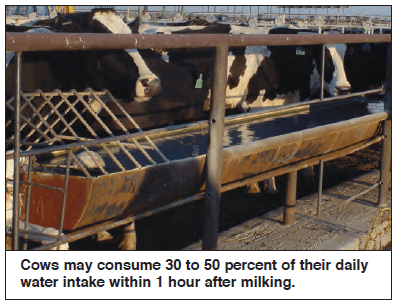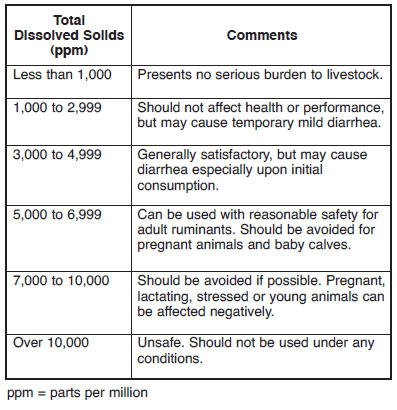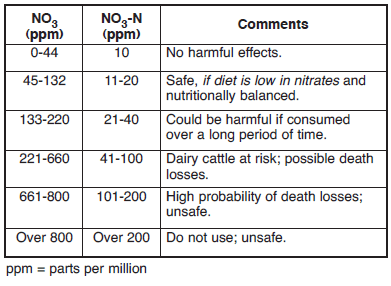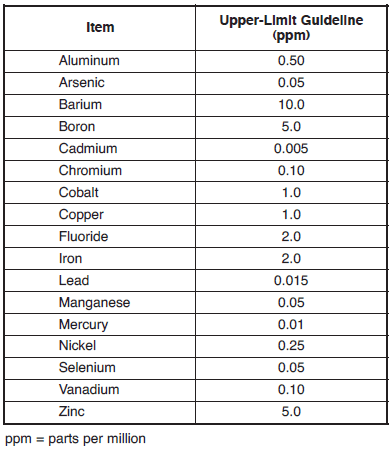Water for Dairy Cattle
Quantity and Quality of Water for Dairy Cattle
Published: August 14, 2012
By: Dr. Michael Looper (Professor and Head, Department of Animal Science, University of Arkansas)
Introduction
Water constitutes 60 to 70 percent of a livestock animal's body. Water is necessary for maintaining body fluids and proper ion balance; digesting, absorbing and metabolizing nutrients; eliminating waste material and excess heat from the body; providing a fluid environment for the fetus; and transporting nutrients to and from body tissues. Dairy cattle get the water they need by drinking and consuming feed that contains water, as well as from metabolic water produced by the oxidation of organic nutrients. Water loss from the body occurs via urine, feces and milk; through sweating; and by evaporation from body surfaces and the respiratory tract. The amount of water lost from a cow's body is influenced by the animal's activity, air temperature, humidity, respiratory rate, water intake, feed consumption, milk production and other factors. This publication covers water intake guidelines and water quality issues for dairy cattle.

Water Intake and Requirements
Lactating Cows – Drinking water or free water intake satisfies 80 to 90 percent of a dairy cow's total water needs. The amount of water a cow drinks depends on her size and milk yield, quantity of dry matter consumed, temperature and relative humidity of the environment, temperature of the water, quality and availability of the water, and amount of moisture in her feed. Water is an especially important nutrient during periods of heat stress. The physical properties of water are important for the transfer of heat from the body to the environment. During periods of cold stress, the high heat capacity of body water acts as insulation – conserving body heat. Water intake for lactating cows can be predicted from the following equation:

The equation predicts water consumption will change 1.58 pounds for each 1.0pound change in dry matter consumed, 0.90 pound for each 1.0pound of milk produced, 0.11 pound for each gram of sodium consumed and 1.47 pounds for each degree Fahrenheit (F) change in weekly mean minimum temperature. Weekly mean minimum temperature typically is 10° to 15°F lower than mean daytime temperature. Table 1 lists the estimated daily water intake for lactating cows using the above equation.
TABLE 1. Estimated daily water consumption for a 1,500-pound lactating cow producing 40 to 100 pounds of milk dailya.

Dry Cows – The major factors affecting free water intake of dry cows are concentration of dry matter in the diet, dry matter intake and amount of protein in the diet. Water intake of dry cows can be estimated by the following equation:

For example, a 1,500pound nonlactating cow that eats 28 pounds of dry matter containing 12 percent moisture and 12 percent crude protein would consume 96 pounds (11.6 gallons) of water per day at air temperatures between 50ºF and 80ºF. Water intake may be 120 to 200 percent greater during periods of heat stress.
Calves and Heifers – During the liquid feeding stage, calves receive most of their water as milk or milk replacer. However, studies show that calves offered water by free choice in addition to a liquid diet gain faster and consume dry feed earlier than calves provided water only in their liquid diet. Therefore, it is recommended to provide water by free choice to calves receiving liquid diets to enhance growth and dry matter intake.
Weaned dairy heifers consume approximately 1.0 to 1.5 gallons of water per 100 pounds of body weight (Table 2). As with all livestock, water should be fresh, clean and always available. Care should be taken to ensure adequate water supplies during periods of heat stress.
TABLE 2. Estimated water intake for dairy heifers.

Drinking Behavior
Providing the opportunity for livestock to consume a relatively large amount of clean, fresh water is essential. Water is consumed several times per day and generally is associated with feeding or milking. Cows may consume 30 to 50 percent of their daily water intake within 1 hour after milking. Reported rates of water intake vary from 1 to 4 gallons per minute. On the basis of farm studies, the length of water troughs should be 2 inches per cow with an optimal height of 2432 inches. Reducing the height 2 to 3 inches may be logical for Jerseys. Water depth should be a minimum of 3 inches to allow the animal to submerge its muzzle 1 to 2 inches. Provide at least one watering device for every 15 to 20 cows, or a minimum of 2 feet of tank space per 20 cows. At least two water locations are needed in the loafing area for each group of cows. For confinement operations, waterers should be allocated at milking parlor exit and within 50 feet of the feed bunk or at every crossover in freestall barns. Heifers should be provided at least one watering space per 20 animals with a minimum of two waterers per group.
The temperature of drinking water has only a slight effect on drinking behavior and animal performance. Under most circumstances, responses to chilling water would not warrant the additional cost.

Given a choice, cows prefer to drink water with moderate temperatures (63°82°F) rather than very cold or hot water.
Water Quality
Water quality is an important issue in dairy cattle production and health. The five properties most often considered in assessing water quality for both humans and livestock are organoleptic properties (odor and taste), physiochemical properties (pH, total dissolved solids, total dissolved oxygen and hardness), along with the presence of toxic compounds (heavy metals, toxic minerals, organophosphates and hydrocarbons), excess minerals or compounds (nitrates, sodium sulfates and iron) and bacteria and algae. Research on water contaminants and their effects on cattle performance are sparse. The following discussion attempts to define some common water quality problems in relation to cattle performance.
Salinity, total dissolved solids (TDS) and total soluble salts (TSS) are measures of constituents soluble in water. Sodium chloride is the first consideration in this category. Other components associated with salinity, TDS or TSS are bicarbonate, sulfate, calcium, magnesium and silica. A secondary group of constituents, found in lower concentrations than the major constituents, includes iron, nitrate, strontium, potassium, carbonate, phosphorus, boron and fluoride. Guidelines for TDS in water for dairy cattle are presented in Table 3.
TABLE 3. Guidelines for use of saline waters for dairy cattle.

Research has shown feedlot cattle drinking saline water (TDS = 6,000 parts per million, ppm) had lower weight gains than cattle drinking normal water (TDS = 1,300 ppm), when the ration's energy content was low and during heat stress. Highenergy rations and cold environmental temperatures negated the detrimental effects of highsaline water consumption. Likewise, milk production of dairy cows drinking saline water (TDS = 4,400 ppm) was not different from that of cows drinking normal water during periods of low environmental temperature. But it was significantly lower during summer months. Cows offered salty water drank more water per day (36 versus 32 gallons per cow) over a 12month period than cows drinking normal water.
Hardness is generally expressed as the sum of calcium and magnesium reported in equivalent amounts of calcium carbonate. Other cations in water, such as zinc, iron, strontium, aluminum and manganese, can contribute to hardness but usually are very low in concentration compared with calcium and magnesium. Hardness categories are listed in Table 4. Water hardness has no effect on animal performance or water intake.
TABLE 4. Water hardness guidelines.

Nitrate can be used in the rumen as a source of nitrogen for synthesis of bacterial protein, but reduction to nitrite also occurs. When absorbed into the body, nitrite reduces the oxygencarrying capacity of blood and, in severe cases, results in asphyxiation. Symptoms of nitrate or nitrite poisoning are labored breathing, rapid pulse rate, frothing at the mouth, convulsions, blue muzzle and bluish tint around eyes, and chocolate brown blood. More moderate levels of nitrate poisoning have been linked to poor growth, infertility problems, abortions, vitamin A deficiencies, reduced milk production and general unhealthiness. The general safe concentration of nitrate in water is less than 44 ppm and less than 10 ppm of nitratenitrogen (Table 5). In evaluating potential nitrate problems, feed also should be analyzed for nitrate in that the effects of feed and water are additive.
TABLE 5. Concentration of nitrates (NO3) and nitrate-nitrogen (NO3-N) in drinking water and expected response.

Sulfate guidelines for water are not welldefined, but general recommendations are less than 500 ppm for calves and less than 1,000 ppm for adult cattle. When sulfate exceeds 500 ppm, the specific salt form of sulfate or sulfur should be identified, since the form of sulfur is an important determinant of toxicity. Hydrogen sulfide is the most toxic form, and concentration as low as 0.1 milligram per liter can reduce water intake. Common forms of sulfate in water are calcium, iron, magnesium and sodium salts. All are laxative, but sodium sulfate is the most potent. Cattle consuming water high in sulfates (2,0002,500 ppm) show diarrhea initially but appear to become resistant to the laxative effect. Iron sulfate has been reported to be the most potent depressor of water intake compared with other sulfate forms. Water and feed with high sulfate contents have been linked to polioencephalomalacia (thiamin deficiency) in beef calves.
pH is a measure of acidity or alkalinity. A pH of 7 is neutral, less than 7 is acidic and more than 7 is alkaline. Little is known about the specific pH's effect on water intake, animal health and production or the microbial environment in the rumen. The preferred pH of drinking water for dairy animals is 6.0 to 8.0. Waters with a pH outside of the preferred range may cause nonspecific effects related to digestive upset, diarrhea, poor feed conversion and reduced water and feed intake.
Microbiological analysis of water for coliform bacteria and other microorganisms is necessary to determine sanitary quality. Since some coliform bacteria are soil borne or nonfecal, a fecal coliform test may be used to determine if the source of total coliform is at least in part from feces. A fecal streptococci test may be run on fresh samples to determine if the contamination is from animal or human sources. If fecal coliforms exceed fecal streptococci, human sources of pollution may be suspect. If fecal streptococci exceed fecal coliform, animal sources of pollution are indicated. For animal consumption, especially young calves, total and fecal coliform counts should be less than 1 per 100 milliliters. For adult animals, total and fecal coliform counts should be under 15 and 10 per 100 milliliters, respectively. It is recommended that fecal streptococci counts not exceed 3 or 30 per 100 milliliters for calves and adult cattle, respectively.
Total bacteria count measures virtually all pathogenic as well as noninfectious bacteria that use organic nutrients for growth. Total bacteria counts in excess of 500 per 100 milliliters may indicate waterquality problems. Water sources with total bacteria counts in excess of 1 million per 100 milliliters should be avoided for all livestock classes. Most water supplies will have counts below 200 per 100 milliliters continuously.
Blue-green algae have been reported to cause illness when cattle are allowed to consume water containing this organism. Although the causative agent has not been identified specifically, cattle should be prevented from drinking water with heavy algae growth. Symptoms in bluegreen algae poisoning include ataxia or incoordination of voluntary muscle movement, bloody diarrhea, convulsions and sudden death. This is an occasional problem in freestanding water, such as farm ponds. Shading water troughs and frequent sanitation will minimize algae growth.
Other potentially toxic compounds and organisms sometimes are found in water and can pose a health hazard to cattle. For safe consumption, water contaminants should not exceed the guidelines in Table 6. However, many dietary, physiologic and environmental factors affect these guidelines and make it impossible to accurately determine the concentrations at which problems may occur.
TABLE 6. Generally considered safe concentrations of some potentially toxic nutrients and contaminants in water for cattle.

Water Sampling and Testing
Typically, 1 or 2 quarts of water from the source in question should be adequate to complete any needed tests. Samples may be sent to any accredited commercial or stateoperated laboratory for analyses. Producers should consult with their herd veterinarian or state Extension personnel for assistance in selecting a laboratory, as well as for assistance in selecting appropriate tests and interpreting results.
Summary
Water availability and quality are extremely important for animal health and productivity. Limiting water availability to cattle will depress production rapidly and severely.
The most common waterquality problems affecting livestock production include high concentrations of minerals (excess salinity), high nitrogen content (nitrates and nitrites), bacterial contamination, heavy growth of bluegreen algae and accidental contamination by petroleum, pesticides or fertilizer products.
On the basis of the scientific literature, no widespread specific production problems have been caused by consumption of lowquality water. Poor water quality might cause reduced production or nonspecific diseases and should be one aspect investigated when there are herd health and production problems.
References
Beede, D. K. 1992. Water for Dairy Cattle. In: Large Dairy Herd Management. Ed. H. H. Van Horn and C. J. Wilcox. Amer. Dairy Sci. Assoc. Champaign, IL.
Dairy Practices Council. 1990. Guidelines for Potable Water on Dairy Farms, 3rd rev. ed. Barre, VT.
McFarland, D. F. 2000. Feed Area and Water Space Design. In: Dairy Housing and Equipment Systems. NRAES129. Ithaca, NY.
Murphy, M. R., C. L. Davis and G. C. McCoy. 1983. Factors Affecting Water Consumption by Holstein Cows in Early Lactation. J. Dairy Sci. 66:35.
National Research Council. 2001. Nutrient Requirements of Dairy Cattle, 7th rev. ed. Washington, DC: National Academy Press.
Related topics:
Authors:

Recommend
Comment
Share

Would you like to discuss another topic? Create a new post to engage with experts in the community.














